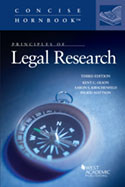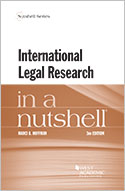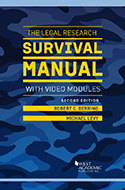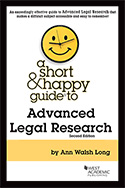
Legal Research in a Nutshell
Author:
Olson, Kent C.
Edition:
14th
Copyright Date:
2021
21 chapters
have results for legal research in a nutshell
Chapter 8 Specialized and Nonlegal Resources 95 results (showing 5 best matches)
- This Nutshell examines legal research generally, but researchers should be aware that each area of law has its own idiosyncrasies. Specialized research guides have been published as monographs and in journals such as
- Legal materials can vary greatly from state to state, and law library websites often have guidance on legal research issues in their home jurisdictions. Appendix A lists state-specific research guides, which can provide valuable details and information on sources.
- Specialized Legal Research
- Most legal research involves determining the law now in effect, but you may at times need information on legal developments occurring decades or centuries ago. The background of a court decision, statute, or constitutional provision is of more than historical interest because it can continue to influence present day interpretation.
- Business developments are a major focus of research in many legal practices. Information on companies can often be found through their websites, and a number of print and online business directories are published. The amount of available information depends in part on whether a company is publicly or privately held.
- Open Chapter
Chapter 10 The Law of Other Countries 64 results (showing 5 best matches)
- Research in foreign legal systems generally is discussed in Marci Hoffman & Mary Rumsey’s
- An American lawyer or law student researching the law of a civil law country must be cognizant of the major differences between the civil and common law systems, and the effect of these differences on how legal issues are evaluated and researched. In theory, a code in the civil law tradition is designed to cover all legal situations that might occur. Instead of searching for precedents in factually similar judicial decisions, a civil law researcher would look first to the abstract provisions of the code for a logical and appropriate legal principle.
- Secondary sources are invaluable in civil law research. Scholarly commentary is given great weight by civil lawyers, and leading treatises are essential resources. Civil law countries also have a multitude of legal periodicals commenting on legal developments and often printing legislative texts and judicial decisions. In France, for example, the leading legal periodicals
- A number of guides to the legal systems of specific countries are published in English. These generally explain legal institutions, summarize major principles, and have leads to research resources. Recently published titles include Jean-Marie Kamatali,
- While thorough research on a foreign law issue requires you to read the original primary sources, you can develop a working knowledge of major legal issues through print and online reference materials. You will usually want to begin with an encyclopedia or treatise for a general introduction to a national legal system or a specific subject, before searching for translations or summaries of the primary sources. Foreign law research guides describing and linking to sources can help you discover the available resources.
- Open Chapter
Chapter The Research Process 107 results (showing 5 best matches)
- If you are a law student, legal research works hand in hand with the legal analysis skills you learn in classes like Torts and Constitutional Law. These substantive law school classes teach you to evaluate factual situations and to determine the relevant issues. Legal research skills give you the ability to identify the specific rules that apply to a particular situation. They lead to the knowledge you need to provide accurate and insightful advice, to draft effective documents, and to defend your clients’ rights. Ineffective research wastes time and money, and inaccurate research is malpractice.
- Methods of legal research using specialized resources such as case digests and annotated codes will be discussed in later chapters, but online legal research has several basic characteristics no matter what type of sources are being explored.
- An essential part of legal research is verifying that the information you’ve found is current. You must make sure that your sources are still in force and “good law.” No research is complete unless you have checked the latest supplements, searched current-awareness sources for new developments, and determined the status of cases and statutes to be relied upon.
- Legal research is the process of identifying the legal rules that govern an activity and finding sources that explain or analyze those rules. Successful research gives you confidence that you’re not missing any important pieces that might undermine the conclusions you reach.
- If you are a citizen who needs to do legal research to protect your own rights, an increasing amount of legal information is available from free internet sources. We will highlight these free resources throughout this volume, although some of the more sophisticated tools and analyses such as treatises and annotated codes are available only from subscription services or in public law libraries.
- Open Chapter
Chapter 9 International Law 93 results (showing 5 best matches)
- ), which publishes several dozen research guides on specific organizations and topics. Marci Hoffman & Mary Rumsey,
- A modern legal practice often requires knowledge of international and foreign law. If you are representing an American firm investing in another country, for example, you must be aware of treaties between the two nations as well as the investment and trade laws of both countries. You may also need to examine jurisdictional issues in resolving disputes or in determining the application of one country’s rules in the other’s courts. This chapter focuses on international law, while research in the law of foreign countries is the subject of Chapter 10.
- As in other areas, the first step in approaching most research problems in international law is to turn to a reference work, a treatise, or a law review article for general information and for help in analyzing the issues involved.
- Treaty research generally involves several aspects: (1) finding its text in an authoritative source; (2) determining whether it is in force and with what parties and reservations; and (3) interpreting its provisions, with the aid of commentaries, judicial decisions, and legislative history. What resources to use depends in part on whether the United States is a party.
- National governments are the major parties in international law, but worldwide and regional intergovernmental organizations (IGOs) play a vital role by establishing norms, promoting multilateral conventions, and providing mechanisms for the peaceful resolution of conflicts. Even when not acting as lawmaking bodies, IGOs compile and publish many of the major research sources in international law.
- Open Chapter
Chapter 2 Background and Analysis 83 results (showing 5 best matches)
- Primary sources of law—such as constitutional provisions, legislative enactments, and judicial decisions—determine legal rights and govern procedures. Primary sources, however, are difficult places in which to find answers at the beginning of a research project. Secondary sources that explain and analyze governing legal doctrines make primary sources more accessible and should serve as launching pads for most research projects.
- Secondary legal literature is much broader than the basic resources discussed in this chapter, and additional specialized materials will be introduced in later chapters. These general works, however, can provide a solid start to successful research of most legal issues.
- Ultimately the deciding factor in determining whether you will turn to a text a second time is whether it helped answer your question. Did it clarify matters and provide fruitful research leads? A reliable treatise allows you to explore an unfamiliar area with the help of an experienced and insightful guide. As your knowledge of a particular area of law grows, you will develop a sense of which sources are best for background information, for working through a complicated legal issue, or for references to further research sources.
- For articles not available in full text from Legal Source or ILP, many libraries offer “link resolvers” that lead directly from an index entry to the full text in HeinOnline or other resources. This method combines the best of both research worlds: expert indexing to ensure that relevant articles are found, and immediate online access to the text.
- The academic legal journals known as law reviews are the major forum through which legal scholars debate and develop legal theories. Most law review articles have two features that make them invaluable in research. They generally begin with an introductory overview of the area of law that summarizes the relevant doctrine and literature, and they are usually replete with footnotes citing to primary sources and other secondary sources.
- Open Chapter
Preface 5 results
- Most legal research can be performed from anywhere with an internet connection, but keywords and algorithms have not fully supplanted the sophisticated editorial tools that shaped our legal literature. Many online sources are based on printed works and incorporate their structure and logic, and an understanding of their purpose and scope is needed for effective research whether it is done online or in print. Finding an answer to a legal question is easier than ever. Finding a correct and complete answer requires as much skill as it did in the print era.
- This is the fourteenth edition of a book that began as the late Morris Cohen’s brainchild in the 1960s. Times have certainly changed in all those years, but the need for lawyers, paralegals, and scholars to do legal research effectively and confidently remains. It has been my honor to collaborate with Morris and to carry on his work.
- The book does not include illustrations of the resources discussed, as small black-and-white screenshots hardly do justice to online resources. Illustrations are instead available on to the Nutshell’s companion website (
- In addition to print-based resources and major online services such as Westlaw and Lexis, the text discusses a wide range of government and commercial websites. Links to all of these sites, including specific resources in HeinOnline and other collections, are available on the book’s companion website.
- This book was prepared during the Covid era, when students everywhere had to transition to a very different academic experience. Although there have obviously been much worse hardships and losses wrought by the pandemic, your sacrifices have been appreciated. May they be a receding memory by the time you read this.
- Open Chapter
Chapter 5 Legislative Information 95 results (showing 5 best matches)
- A guide to legislative research for a specific state can be invaluable. Most of the published state legal research guides listed in Appendix A discuss available legislative history resources for their states. State bar journals frequently publish articles on legislative history research. Law library websites in the jurisdiction you are researching may have guides to doing legislative history research in their state. Indiana University’s “State Legislative History Research Guides Inventory” (
- While researchers are interested in Congress for numerous reasons, this discussion focuses on tools useful for two important legal research tasks: investigating the meaning of an enacted law and tracking the status of pending legislation. You can use a number of approaches for these purposes. For recently enacted laws and pending legislation, several electronic resources are available. For older bills, the choices dwindle to a few tools with retrospective coverage.
- In almost half of the states, statutes or constitutional amendments can bypass the legislature and be submitted directly to voters through the initiative process. Many states also permit popular referendums, ballot measures to reject measures enacted by the legislature. Information on the enactment and intent of these measures may not appear in the standard legislative history sources. The Initiative & Referendum Institute at the University of Southern California (
- Identifying and gathering the documents that make up a legislative history can be a time-consuming process, and a resource that has already compiled these documents can make your research much easier. Such resources, online and in print, are available for many federal acts.
- One of the most useful resources in legislative history research is the Law Librarians’ Society of Washington, D.C.’s Legislative Source Book ( ). This site includes features such as links to congressional committee publications, questions and answers on legislative research, and a practitioner’s guide to compiling a federal legislative history.
- Open Chapter
Copyright Page 7 results (showing 5 best matches)
- Nutshell Series, In a Nutshell
- The publisher is not engaged in rendering legal or other professional advice, and this publication is not a substitute for the advice of an attorney. If you require legal or other expert advice, you should seek the services of a competent attorney or other professional.
- Printed in the United States of America
- © West, a Thomson business, 2003
- © 2013 LEG, Inc. d/b/a West Academic Publishing
- Open Chapter
Chapter 3 Case Law 113 results (showing 5 best matches)
- This chapter discusses several major tools to help you find cases and affirm their validity, but it is not exhaustive. Much of legal research revolves around finding cases, and several resources discussed in other chapters—such as treatises, annotations, law reviews, and annotated codes—are also valuable in case research.
- The easiest way to use a digest is to work from the key numbers assigned to cases known to be on point, but you can also begin your research in a Descriptive-Word Index shelved at the beginning or the end of a digest set. This index lists thousands of factual and legal terms, with references to key numbers.
- In online case research, you first choose whether or not to limit a search to a specific jurisdiction. For some issues, it may not matter what courts in other states have decided. The only relevant cases are those from a particular state or within a narrow doctrinal area. For other research questions, cases from other jurisdictions can be persuasive authority or may provide useful analogies.
- Citing references: Research leads to later citing cases, as well as law review articles, annotations, and other resources, enabling you to find related cases and to trace the development of a legal doctrine forward from a known case to the present.
- Case Research.
- Open Chapter
Chapter 7 Court Rules and Practice 51 results (showing 5 best matches)
- are useful in research because they provide a concise summary of a jurisdiction’s law on the issues covered, often accompanied by notes summarizing the leading cases. They can serve the same function as a or legal encyclopedia in outlining a state’s basic legal doctrines.
- As in other areas of law, you will usually want to begin your research by consulting secondary sources. The leading treatise is Geoffrey C. Hazard, Jr. et al., (4th ed. 2015–date, available on Cheetah), a two-volume set designed as a workbook “for lawyers faced with immediate practical dilemmas.” Other resources include Ronald D. Rotunda & John S. Dzienkowski,
- Most states also have annual paperback volumes with rules and procedural statutes. More in-depth works in larger jurisdictions, such as (both available on Westlaw), have scholarly commentaries on the rules and analysis of relevant case law. The state legal research guides listed in Appendix A can tell you about these and other jurisdiction-specific resources.
- Litigators need to be familiar with these materials, but their value also extends to other legal research situations. All lawyers must follow rules of professional conduct, and resources such as briefs and model jury instructions can be useful resources for understanding and analyzing legal issues.
- The Federal Sentencing Guidelines are not court rules, but they occupy a similar position in the hierarchy of legal authorities. Judges must consider the guidelines in determining punishments for criminal convictions. The U.S. Sentencing Commission, an independent agency within the judicial branch, first promulgated the guidelines in 1987 and has revised them numerous times. The commission publishes its ) and in print.
- Open Chapter
Chapter 4 Statutes and Constitutions 96 results (showing 5 best matches)
- is not the most convenient source for federal legislation, its role in legal research is vital. In most instances it is the official statement of the law, and it is a necessary source for determining the specific language Congress enacted at any given time.
- You can also find information on resources for territorial and early state constitutions in
- have listings by state of the names and citations of current official and commercially published codes. State legal research guides (listed in Appendix A) provide information about earlier codes and statutory revisions for individual states.
- Statutory research is one area where online resources have not wholly supplanted print. Even experienced researchers who do most of their work online find that printed code volumes can be of value in statutory research. Print can make it easier to find related provisions and to place a section in its context. Statutory provisions often have multiple subsections and sub-subsections, and you need to understand how these different subsections relate to each other. You also need to see an entire code chapter or title to understand the context and purpose of an individual section. Skimming through a few pages in a code volume can be easier than going from document to document in an online service. We nonetheless begin our discussion with online resources, the most common starting points for statutory research.
- for thorough research of a particular statute. Each has selective annotations of court decisions, and a relevant case may be included in one but not the other. ’s annotations are generally more extensive, but some court decisions appear only in
- Open Chapter
Chapter 6 Administrative Law 107 results (showing 5 best matches)
- As with statutes, chronological publication of regulations is insufficient for most legal research. You must know what regulations are currently in force regardless of when they were first promulgated. The , published since 1938 to meet this need, now consists of more than 230 paperback volumes revised on an annual basis.
- Cities and counties are administrative units of the states, with lawmaking powers determined by the state constitution or by legislative delegation of authority. They create a variety of legal documents that can be important in legal research. are local enactments governing specific issues. In addition many localities have administrative agencies that issue rules or decisions.
- When researching administrative law, you need to determine what agency has jurisdiction and develop a preliminary understanding of its structure and functions. Most agencies are formed by legislation that defines their purpose and limits their parameters. You should understand an agency’s legal mandates and information sources before delving into the documents it produces.
- with information about government agencies and officials. Some of these explain state agency functions and publications, while others simply have contact information. They are described in the annual , along with information about reference works, statistical abstracts, and other sources, as well as in state legal research guides.
- State attorney general opinions, issued in response to questions from government officials, can have considerable significance in legal research. Although these opinions are advisory and have no binding authority, they are given considerable weight by the courts in interpreting statutes and regulations. Most states publish attorney general opinions in bound volumes. Many attorneys general also have recent opinions on their websites, which can be found through links at the National Association of Attorneys General website ( general opinions are available on Westlaw and Lexis, with coverage in most states beginning in 1977 or earlier. HeinOnline’s State Attorney General Reports and Opinions collection provides retrospective coverage to the earliest published volumes.
- Open Chapter
Appendix A State Legal Research Guides 57 results (showing 5 best matches)
Index 86 results (showing 5 best matches)
Outline 51 results (showing 5 best matches)
Center Title 2 results
Index Part 2 16 results (showing 5 best matches)
Appendix B Major Treatises and Services by Subject 35 results (showing 5 best matches)
- Legal Rights of Children
- LEGAL ETHICS
- Legal Malpractice
- Legal Ethics: The Lawyer’s Deskbook on Professional Responsibility
- Most of the treatises listed, but not all, are available online through Westlaw, Lexis, Wolters Kluwer’s Cheetah, or Bloomberg Law. The single-volume hornbooks are generally online in either West Academic Study Aids Collection or Wolters Kluwer Law School Study Aids. In a few instances marked by asterisks, treatises on Westlaw are not available to law school subscribers if a related hornbook is published by West Academic.
- Open Chapter
Dedication 1 result
- Publication Date: May 7th, 2021
- ISBN: 9781636590639
- Subject: Legal Research
- Series: Nutshells
- Type: Overviews
-
Description:
Finding and using legal resources effectively is an essential skill for lawyers. This comprehensive but succinct guide covers research procedures using major online services, free Internet resources, and library materials. Several hundred websites are discussed and placed in context for effective and productive use in research. Discussion includes coverage of legislative history, administrative law, specialized and interdisciplinary resources, and research in international and comparative law. Appendices list state research guides and treatises and services by subject, and a companion website has a regularly updated list of URLs and illustrations of online and print resources.
For more information and additional teaching materials, visit the companion site.



